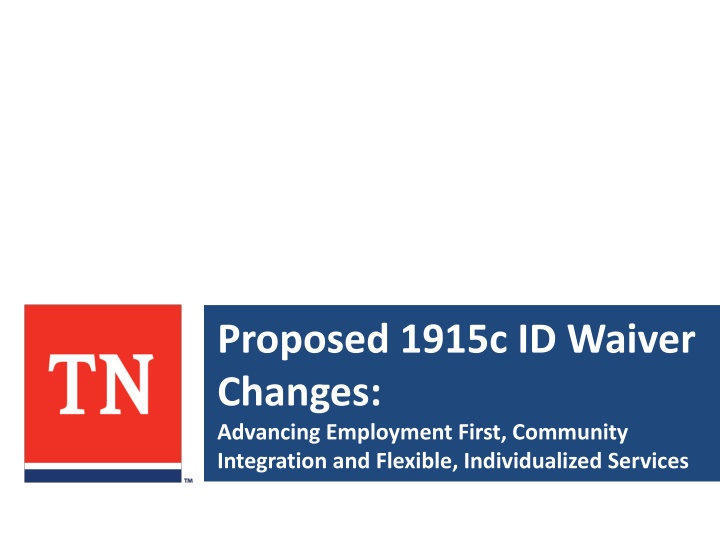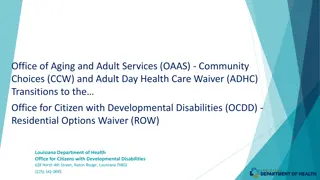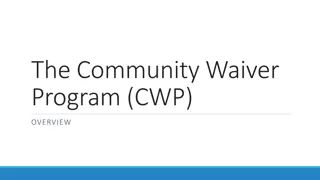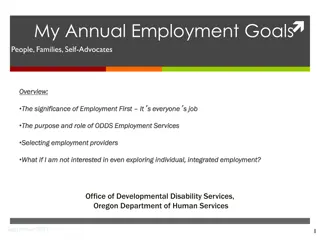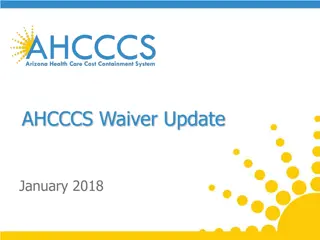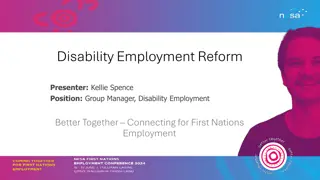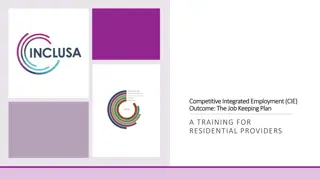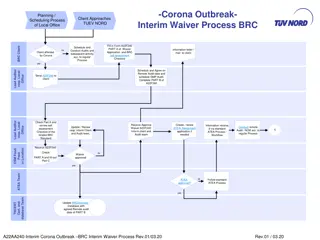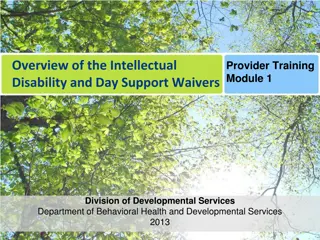Advancing Employment First: Proposed 1915c ID Waiver Changes
Proposed changes to the 1915c ID waiver aim to prioritize employment first, enhance community integration, and provide flexible, individualized services in Tennessee's IDD system. The initiative addresses challenges in current supported employment funding and aims to improve employment outcomes for individuals with ID waivers.
Download Presentation

Please find below an Image/Link to download the presentation.
The content on the website is provided AS IS for your information and personal use only. It may not be sold, licensed, or shared on other websites without obtaining consent from the author.If you encounter any issues during the download, it is possible that the publisher has removed the file from their server.
You are allowed to download the files provided on this website for personal or commercial use, subject to the condition that they are used lawfully. All files are the property of their respective owners.
The content on the website is provided AS IS for your information and personal use only. It may not be sold, licensed, or shared on other websites without obtaining consent from the author.
E N D
Presentation Transcript
Proposed 1915c ID Waiver Changes: Advancing Employment First, Community Integration and Flexible, Individualized Services
Employment First Tennessee IDD system first in country to adopt Employment First policy (2002) Numerous adjustments over the years to try to ensure financial incentives for supported employment in 1915c waivers Employment outcomes still have significant room for improvement
Employment Data 2016/2017 Data Roughly 14% of ID waiver participants in individual integrated employment TennCare Employment Survey and National Core Indicators Shows 1 in 3 people on ID waivers who don t have an integrated job want one (21% of ID waiver participants)
Day Rates Day Rates create challenges in providing flexible, individualized services: 6 hour rule to bill SE day rates not enough of an incentive to substantially increase SE participation No funding for pre-employment services to get people jobs Any time spent at home means billing entire day at In Home Day rate, discouraging employment or community involvement
Day Rates According to data collected by TennCare earlier this year, the average time spent in the community for a person receiving IHD was 22 minutes of a six hour day; regardless of the level of needed approved for IHD
Current Supported Employment Funding Where is it invested? 2,920 total hours of SE reported for 1,040 billed days 1,040 billed days assumes 6 hours/day or 6,240 total hours Only 47% of hours reimbursed through SE day rates is actually SE hours (person working in SE) Only 1,756 hours reimbursed through SE day rates is actually SE job coaching (service actually provided) Only 28% of total hours reimbursed through SE day rates are hours where SE service was actually provided to a person
Current Supported Employment Funding Where is it invested? Only 28% of total hours reimbursed through SE day rates are hours where SE service was actually provided to a person Most of SE funding (72%) is being paid for services other than SE or for hours people are working in SE where they do not need a job coach
Proposed Changes Designed to increase opportunities for Employment and Community Participation Aligns Waiver Day and Employment Services with Federal and State Policies including the HCBS Setting s Rule Provides more flexibility for waiver participants receiving Employment and Day Services Provides more flexibility for providers delivering Employment and Day Services
Proposed Changes Ability to use home as a base from which to access community and employment opportunities Establishes distinct day and employment services Provides more flexibility for providers delivering Employment and Day Services
Proposed Changes Eliminate six hour requirement to bill employment or day services on a particular day Change to 15 minute units Allows providers to bill for services delivered on days currently considered unbillable Allows TennCare and DIDD to ensure that they are more appropriately reimbursing for the specific type and amount of services actually provided
Proposed Changes Add specific, time-limited pre-employment services to assist waiver participants to obtain competitive integrated employment Utilize a rate structure that aligns financial incentives with policy goals Incentivize and reward best practice job coaching through tiered and phased payment structure
Proposed Changes Quality incentive payment for supported employment providers supporting individuals working in competitive integrated employment at least 15 hours per week Maintain current funding levels for employment and day services as a whole
Separate Service Categories New Service Category Supported Employment Individual Supported Employment Small Group Community Participation Supports Intermittent Employment & Community Participation Wrap Around Facility-Based Day Services Residential Special Needs Adjustment - Homebound Non-Residential Homebound Support Service
Reimbursement Rates Started process by converting all current employment and day service rates to equivalent 15 minute unit rates Day service rate divided by 24 equals the 15 minute unit rate
Moving to 15 Minute Units of Service Flexible mix of services can be provided in any given day: No 6 hour requirement to bill on a particular day 243 days converted to 1,458 hours; 5832 fifteen minute units Up to 60 hours within each 14 day billing cycle (can be spread across all days in billing cycle)
Straight Conversion of 6 Hour Day Rates Community-Based Day 15 minute unit rates based on current day rates
Pre-Employment Services Added three different pre-employment services as part of Supported Employment Individual Services that support providers to assist more waiver participants to obtain individualized, competitive integrated employment
Pre-Employment Services Adopting options available in ECF CHOICES Exploration (average 40 hours over 30 days) Paid on outcome basis: $1,091 Budgeting 750 people per year will receive this service Discovery (average 50 hours over 90 days) Paid on outcome basis: $1,500 Budgeting 900 people per year will receive this service
Pre-Employment Services Adopting Job Development options available in ECF CHOICES Job Development Average 40 hours for low acuity ($1,200 outcome) Anticipating 300 people not served by VR Average 60 hours for mid acuity ($1,800 outcome) Anticipating 200 people not served by VR Average 80 hours for high acuity ($2,400 outcome) Anticipating 100 people not served by VR
Incentivizing Individual Employment Quality Incentive Payments for Providers of SE- Individual Employment Support where Waiver Participants are engaged in Certain Levels of Competitive Integrated Employment. Payment earned and paid for additional/atypical effort of provider to assist waiver participant to obtain and retain competitive integrated employment where hours worked are substantially higher than the average for all waiver participants
Incentivizing Individual Employment Two quality payment levels available Base tier payment - $1,500 Based on the waiver participant working in competitive integrated employment between three-hundred ninety (390) and five-hundred nineteen (519) hours in the prior six (6) calendar month period. This is average hourly employment that is at least 15 but less than 20 hours/week. Top tier payment - $2,000 Based on the waiver participant working five-hundred and twenty (520) or more hours in the prior six (6) calendar month period. This is average hourly employment that is 20 hours/week or more A provider may earn the quality payment up to twice a year
Financial Incentives for Employment Increase reimbursement rates for Supported Employment-Individual Job Coaching to ensure providers are fairly compensated for the cost of providing this service in a high quality way Aligning financial incentives for best practice Job Coaching by reimbursing at higher rates when appropriate fading targets are met
Financial Incentives for Employment Adopting reimbursement methodology used on ECF CHOICES Three Job Coaching Rate Levels Depending on Amount of Fading Achieved: $26/hour $23/hour $20/hour* Fading targets based on three levels of acuity $130/month stabilization & monitoring payment *TNCO advised minimum of $20/hour necessary for 1:1 job support.
Supported Employment-Individual Job Coaching - 1/4 Hourly Rates (Hourly Rates) Coach hours as % of work hours Coach hours as % of work hours Coach hours as % of work hours Level 6 (2:1 staffing required; all F2F) Months on job Level 4 Levels 1-3 1 - 6 months $6.50 ($26) $6.50 ($26) 100% $8.91 ($35.64) 90-100% $5.00 ($20) 80-100% $5.00 ($20) 100% $8.91 ($35.64) 7 - 12 months 80-89% $5.75 ($23) 60-79% $5.75 ($23) < 80% $6.50 ($26) < 60% $6.50 ($26) 75-100% $5.00 ($20) 60-100% $5.00 ($20) 100% $8.91 ($35.64) 13 - 24 months 60-74% $5.75 ($23) 40-59% $5.75 ($23) < 60% $6.50 ($26) < 40% $6.50 ($26) 65-100% $5.00 ($20) 50-100% $5.00 ($20) 100% $8.91 ($35.64) 25 + months 40-64% $5.75 ($23) 30-49% $5.75 ($23) < 40% $6.50 ($26) < 30% $6.50 ($26) Stabilization & Monitoring < /= 1hr/wk $130/month < /= 1hr/wk $130/month N/A Note: Face to face service delivery is not required to bill; but time billed must be for activities that meet definition of Job Coaching and that are done, based on the needs of, and for the benefit of, the specific waiver participant for which the time is billed. A unit of a job coach s time may not be billed to more than one waiver participant. Service documentation must support billing consistent with these expectations. 26
Financial Incentives for Employment Eliminate billing for Supported Employment Services when no Job Coaching is provided or other services are provided Re-directs funding to Outcome-Based Services Exploration, Discovery & Job Development Higher Reimbursement Rate for Individual Job Coaching Services
Supported Employment Small Group Reimbursement Rates that reflect size of group and assumed staffing ratio Adjusting down size of groups to ensure opportunities for integration and individual learning/skill acquisition for integrated employment Hourly Cost 15 Minute Unit Cost Description $15.92 $3.98 1:2 Ratio; Max Group Size 2 $10.64 $2.66 1:3 Ratio; Max Group Size 3 $7.80 $1.95 1:4 Ratio; Max Group Size 4
Intermittent Employment and Community Participation Wraparound Service For Wavier Participants who choose to use their home as their base This service covers time using home as base (as needed) for meals, personal care, rebuilding stamina/tolerance Hours of this service can occur before, after or between hour(s) of Supported Employment and/or Community Participation
Home-Base Support Time This service covers time using home as base (as needed) for meals, personal care, rebuilding stamina/tolerance Hourly Cost 15 Minute Unit Cost Former Level/Ratio $9.45 $2.36 Level 1-3 $13.62 $3.40 Level 4 $21.69 $5.42 Level 6
Replacing In Home Day Intermittent Employment & Community Wraparound For people who spend time at home on a given day Three rates per 15 minute unit: Level 1-3 $2.36 Level 4 $3.40 Level 6 $5.42
Replacing In Home Day Up to 4 hours can be billed on same day that a least 2 hours of SE or Community Participation are billed Provides more flexibility for persons served Hours of this service do not have to occur between hour(s) of SE and/or CP in order to be billable Services billed on a given day can be provided by different provider organizations
Facility Based Day Adjusting staffing ratio expectations for Facility Based Day Supports to reflect what is more typical nationally Adjusting rates for Facility Based Day Supports in light of revised staffing ratio expectations Preserving existing staffing ratio and rates for person with most significant needs (Level 4 & 6)
Facility Based Day FB Day still an option (current rules re: authorization would still apply) People can still use facility as base but we are adding option for people to use home as base (like we do) Using home as base avoids incurring time/expense of transportation of person to/from separate facility, and cost to maintain separate facility
Facility Based Day Current FB Day rates (Levels 1-3) 1:8 Level One 1:6 Level Two 1:4 Level Three Daily Rate Hourly Cost 15 Minute Unit Level/Ratio $31.55 $5.26 $1.31 Level 1 1:8 $39.63 $6.61 $1.65 Level 2 1:6 $53.44 $8.91 $2.23 Level 3 1:4 1/6 Current Day Rate 1/24 Current Day Rate
Facility Based Day New FB Day rates (Levels 1-3) based on new staffing ratios typical in other states 1:10 Level One 1:8 Level Two 1:6 Level Three Staff Hour Cost Hourly Cost 15 Minute Unit Former Level/Ratio $41.60 $4.16 $1.04 Level 1 1:10 $41.60 $5.20 $1.30 Level 2 1:8 $41.60 $6.96 $1.74 Level 3 1:6 Level 4/6 No Change to Rates 1/6 Current Day Rate 1/24 Current Day Rate N/A
Residential Special Needs Homebound Adjustment Non-Residential Homebound Support Service Residential Special Needs Adjustment - Homebound and Non- Residential Homebound Support Service for people who cannot leave their home for at least 2 hours on a given day (24 hours). Three rates matching current In-Home Day Rates: Level 1-3 $56.69 Level 4 $81.70 Level 6 $130.12 Payment is per day the SNA or the Non-Residential Homebound Support Service is authorized Maximum 5 days per calendar week; 10 days in 14 day billing period. Counts as equivalent of 6 hours for the 14 day limit of 60 hours and the annual limit of 1,458 hours Cannot bill any other employment/day service on a day this SNA or Non-Residential Homebound Support Service is authorized. New guidelines and process for approving
Payment of Services For each billing period, SE claims will be paid first; SE Small Group claims second; then Community Participation claims; then Intermittent Employment and Community Participation Wrap Around claims, then Facility Based claims; then Residential Special Needs Adjustment Homebound/Non-Residential Homebound Support Services claims = up to 240 units maximum Services in order to be paid: Supported Employment Individual Supported Employment Small Group Community Participation Supports Intermittent Employment & Community Participation Wrap Around Facility Based Residential Special Needs Adjustment Homebound or Non-Residential Homebound Support Service
Cost Modeling Arrive at final rate structure that aligns financial incentives with policy goals Creates more flexibility for providers and waiver participants Does not reduce current funding for employment and day services
Cost Modeling Two week (14 day) period for data collection (June 19 to July 2, 2017) Collected information on how hours broke down for each billable and non-billable day Number of Providers in Data Set: 54 Number of Individuals in Data Set: 1,883 16,058 units (days) reported during period
Validity of Cost Modeling Cost Modeling Reported Data Category Unbillable FY 2016 372 Data % % Code Description Less than 6 Hours Levels 1 - 3 Level 4 Level 6 Code Description Less than 6 Hours Levels 1 - 3 Level 4 Level 6 Category Unbillable 1.72% 30.34% 25.80% 2.96% - 18.45% 25.69% 3.45% Community Based Service Community Based Service Employment Supports Group Employment Supports Special Needs Employment Supports Ind Employment Supports Group Employment Supports Special Needs Employment Supports Ind Group Employment 0.34% 0.73% Group Employment Special Needs 2.53% 2.92% Special Needs Level 6 0.04% 0.03% Level 6 Individual Employment Level 1 Level 2 Level 3 Level 4 Level 6 In Home Day Level 4 Level 6 Individual Employment Level 1 Level 2 Level 3 Level 4 Level 6 In Home Day Level 4 Level 6 3.90% 4.64% 2.73% 4.45% 3.35% 2.85% 0.01% 4.64% 12.54% 1.77% 4.07% 9.01% 6.43% 6.22% 0.00% 3.74% 13.31% 1.31% Facility Based Day Facility Based Day In Home Day In Home Day
Assumptions re: Utilization Changes Exploration, Discovery, Job Development purchased as explained previously 25% of CB Day (Level 1-3) Hours move to Individual Job Coaching 75% of FB (all levels) move to CB Day (all levels) No change in SE Small Group Hours
Assumptions re: Utilization Changes In Home Day: IHD Level 1-3 assumed 80% hours moved to CB Day Level 1-3 IHD Level 4 assumed 60% hours moved to CB Day Level 4 IHD Level 6 assumed 40% hours moved to CB Day Level 6
Recap of Policy Goals: Reasons for Changes Increased integrated employment participation Increased community participation Using home and home neighborhood as base Flexibility in scheduling for individuals served Further advancing HCBS Settings Rule & ADA/Olmstead compliance
Next Steps Public posting period May 18, 2018 June 18, 2018 Submission date to CMS of 7-1-18 Target implementation date of 10-1-18
Resources 1915c Employment Day Services Proposed Waiver Changes PowerPoint presentation Summary and Description of 1915c Intellectual and Disability Wavier Amendments Employment and Day Service Definitions https://www.tn.gov/didd/providers.html
Feedback Questions and Discussion
